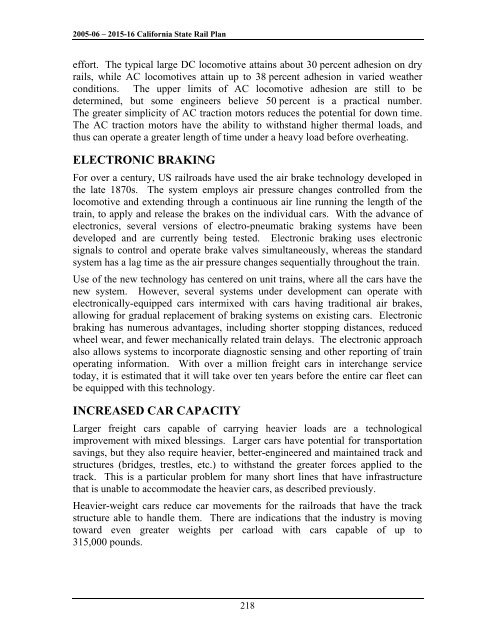California State Rail Plan 2005-06 to 2015-16
California State Rail Plan 2005-06 to 2015-16
California State Rail Plan 2005-06 to 2015-16
You also want an ePaper? Increase the reach of your titles
YUMPU automatically turns print PDFs into web optimized ePapers that Google loves.
<strong>2005</strong>-<strong>06</strong> – <strong>2015</strong>-<strong>16</strong> <strong>California</strong> <strong>State</strong> <strong>Rail</strong> <strong>Plan</strong><br />
effort. The typical large DC locomotive attains about 30 percent adhesion on dry<br />
rails, while AC locomotives attain up <strong>to</strong> 38 percent adhesion in varied weather<br />
conditions. The upper limits of AC locomotive adhesion are still <strong>to</strong> be<br />
determined, but some engineers believe 50 percent is a practical number.<br />
The greater simplicity of AC traction mo<strong>to</strong>rs reduces the potential for down time.<br />
The AC traction mo<strong>to</strong>rs have the ability <strong>to</strong> withstand higher thermal loads, and<br />
thus can operate a greater length of time under a heavy load before overheating.<br />
ELECTRONIC BRAKING<br />
For over a century, US railroads have used the air brake technology developed in<br />
the late 1870s. The system employs air pressure changes controlled from the<br />
locomotive and extending through a continuous air line running the length of the<br />
train, <strong>to</strong> apply and release the brakes on the individual cars. With the advance of<br />
electronics, several versions of electro-pneumatic braking systems have been<br />
developed and are currently being tested. Electronic braking uses electronic<br />
signals <strong>to</strong> control and operate brake valves simultaneously, whereas the standard<br />
system has a lag time as the air pressure changes sequentially throughout the train.<br />
Use of the new technology has centered on unit trains, where all the cars have the<br />
new system. However, several systems under development can operate with<br />
electronically-equipped cars intermixed with cars having traditional air brakes,<br />
allowing for gradual replacement of braking systems on existing cars. Electronic<br />
braking has numerous advantages, including shorter s<strong>to</strong>pping distances, reduced<br />
wheel wear, and fewer mechanically related train delays. The electronic approach<br />
also allows systems <strong>to</strong> incorporate diagnostic sensing and other reporting of train<br />
operating information. With over a million freight cars in interchange service<br />
<strong>to</strong>day, it is estimated that it will take over ten years before the entire car fleet can<br />
be equipped with this technology.<br />
INCREASED CAR CAPACITY<br />
Larger freight cars capable of carrying heavier loads are a technological<br />
improvement with mixed blessings. Larger cars have potential for transportation<br />
savings, but they also require heavier, better-engineered and maintained track and<br />
structures (bridges, trestles, etc.) <strong>to</strong> withstand the greater forces applied <strong>to</strong> the<br />
track. This is a particular problem for many short lines that have infrastructure<br />
that is unable <strong>to</strong> accommodate the heavier cars, as described previously.<br />
Heavier-weight cars reduce car movements for the railroads that have the track<br />
structure able <strong>to</strong> handle them. There are indications that the industry is moving<br />
<strong>to</strong>ward even greater weights per carload with cars capable of up <strong>to</strong><br />
315,000 pounds.<br />
218













